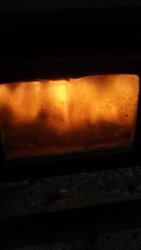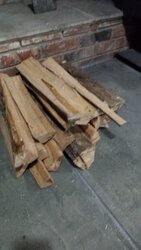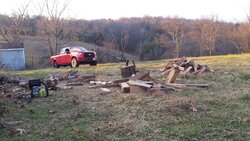so I am having trouble with being able to load my stove, burning mostly pine. (is that normal?)
I failed epicly at cutting up standing dead trees on my property last year, and am burning mostly all (very dry) pine from work, due to procrastination.
so my truble/question:
What is too hot? I have a Lazer thermometer, and read steel gets weak around 800f, so I try to keep the stove hot spots at 700f or less.
I can not load the stove (even full choke) and keep it that low. it runs up to the upper 700's fast! is that ok?
it's a 13mfd epa stove the pipe can get to the upper 500's when the stove is in the upper 700's.
see pic. all the way choked the secondary burn is hot! (rope seals and all are good, and tight)
the good news is: I can go to sleep at 9pm, and not touch it till 4 pm and have coals to work with.
but, it gets could enugh over night, to leave me regretting setting it at full choke before bed.
I failed epicly at cutting up standing dead trees on my property last year, and am burning mostly all (very dry) pine from work, due to procrastination.
so my truble/question:
What is too hot? I have a Lazer thermometer, and read steel gets weak around 800f, so I try to keep the stove hot spots at 700f or less.
I can not load the stove (even full choke) and keep it that low. it runs up to the upper 700's fast! is that ok?
it's a 13mfd epa stove the pipe can get to the upper 500's when the stove is in the upper 700's.
see pic. all the way choked the secondary burn is hot! (rope seals and all are good, and tight)
the good news is: I can go to sleep at 9pm, and not touch it till 4 pm and have coals to work with.
but, it gets could enugh over night, to leave me regretting setting it at full choke before bed.




 If it lies out there long enough and is suspended off the ground, anything will dry after many years. It sounds like that stuff still had some rotting sapwood on it, though, so probably not lying there real long. Sometimes, if they are standing dead for several years, they will get a good head start on drying. You can sometimes tell about how dry it is when cutting....there will be a drier look to the sawed ends. If it was checked on the end of the saw cuts, that's gotta be pretty dry. And of course, the heft of the rounds, which you will get a feel for (but sometimes the sapwood will be wet, which makes 'em a bit heavier.)
If it lies out there long enough and is suspended off the ground, anything will dry after many years. It sounds like that stuff still had some rotting sapwood on it, though, so probably not lying there real long. Sometimes, if they are standing dead for several years, they will get a good head start on drying. You can sometimes tell about how dry it is when cutting....there will be a drier look to the sawed ends. If it was checked on the end of the saw cuts, that's gotta be pretty dry. And of course, the heft of the rounds, which you will get a feel for (but sometimes the sapwood will be wet, which makes 'em a bit heavier.)
